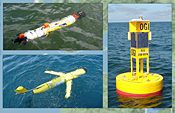You are here
16 May 2009 - Second dye study
A second dye release was conducted several miles north of station CR-15 at 1100. It was released in a ring with a 1 mile diameter. After deploying the dye and taking our first water samples, both ships lost track of the dye location and began searching. The Point Sur used an undulating mini-bat CTD with a fluorometer attached. The New Horizon searched with fluorometers attached to the surface water flow-through system and to the CTD rosette. The dye was released just before a strong ebb, and the drifter we deployed seemed to be caught in the freshwater plume and moved many miles to the WNW. However, a particle tracking model predicted that the dye would move to the south.
After many hours of searching, we cast the CTD in the original Dye Ring location and found very low salinity water at the surface (~10) but no dye. Then we started steaming at 5 Kt directly south of the ring. After 2 miles we detected dye in the surface flow through system. The fluorometer read about 5X higher than background. We stopped, did a CTD and collected water. We collected water samples within and just below the dye, and saw something I have never seen before. There was a half meter layer of freshwater on the surface, and when we looked through it at the yellow ctd cage we could see the wavy lines of freshwater mixing with salt water.
The Point Sur moved in to map the dye with the mini-bat while we continued to steam south at 5 kts and found continuous dye signal in the flow through that reached as high as 50X above background.It appeared that the dye circle was covered over with a layer of freshwater, and that it had not expanded much. In fact, when we steamed through it there were two dye peaks, as though we passed through both sides of the dye circle.
Soon after this we lost the dye again, only to find it several miles to the NW of the last detection point during the slack after flood. We sampled the dye again, and then moved out of the way for the Point Sur to map it with the mini-bat.






